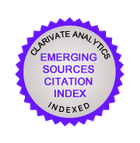Agrarian labour market in EAEU: prerequisites for formation, development trends
https://doi.org/10.29235/1817-7204-2018-56-4-424-436
Abstract
About the Author
V. A. PashkevichBelarus
Pashkevich Volha A. – Ph.D. (Economics), Associate Professor
103 Kazintsa Str., Minsk 220108
References
1. Aliev M. D. Influence of digital economy on the global labor market. Mezhdunarodnaya ekonomika = The World Economics, 2018, no. 3, pp. 39–43 (in Russian).
2. Bukaeva M. S. Peculiarities of labour market regulation in the conditions of globalisation. Vestnik Orenburgskogo gosudarstvennogo universiteta = Vestnik of the Orenburg State University, 2013, no. 8 (157), pp. 13–18 (in Russian).
3. Kotlyarov N. N., Levchenko L. V., Alekseev P. V. Problems and prospects of free movement of labor forces in the EAEU. Ekonomicheskie nauki = Economic Sciences, 2015, no. 12 (133), pp. 137–142 (in Russian).
4. Grebenyuk A. A. How labor migration affects the economy of recipient countries of labour forces. MOSTY. Analitika i novosti o torgovle i ustoichivom razvitii [The BRIDGES. Analytics and News About Trade and Sustainable Dvelopment], 2018, vol. 11, no. 1. Available at: https://ru.ictsd.org/bridges-news/мосты/news/как-трудовая-миграция-влияет-на-экономикустран-реципиентов-рабочей-сил (accessed 15.05.2018) (in Russian).
5. Kim E. Peculiarities of labor migration on the example of Kazakhstan and Uzbekistan. MOSTY. Analitika i novosti o torgovle i ustoichivom razvitii [The BRIDGES. Analytics and News About Trade and Sustainable Dvelopment], 2018, vol. 11, no. 1. Available at: https://ru.ictsd.org/bridges-news/мосты/news/особенности-процессов-трудовой-миграции-напримере-казахстана-и-узбекистана (accessed 15.05.2018) (in Russian).
6. Komarovskii V. V. Labor Migration in modern conditions. MOSTY. Analitika i novosti o torgovle i ustoichivom razvitii [The BRIDGES. Analytics and News About Trade and Sustainable Dvelopment], 2018, vol. 11, no. 1. Available at: https://ru.ictsd.org/bridges-news/мосты/news/о-трудовой-миграции-в-современных-условиях (accessed 15.05.2018) (in Russian).
7. Gostomski E., Mikhalovski T. Reindustrialization in the European Union: methods and factors of its success. Ekonomika i upravlenie = Economics and Management, 2016, no. 3 (47), pp. 46–50 (in Russian).
8. Klavdienko V. P. Labor market regulation in EU countries: national and supranational aspects. Menedzhment v Rossii i za rubezhom = Management in Russia and Abroad, 2008, no. 5, pp. 63–69 (in Russian).
9. Kleshch V. Russia and the EU: Experience in Regional Development Regulation. Problemy teorii i praktiki upravleniya = Theoretical and Practical Aspects of Management, 2018, no. 2, pp. 57–63 (in Russian).
10. Sutyrin V. CIS countries will move closer to the Eurasian Union to access a single labor market. Eurasia. Expert. Available at: http://eurasia.expert/strany-sng-budut-sblizhatsya-s-evraziyskim-soyuzom-dlya-dostupa-k-edinomu-rynku-truda/ (accessed 15.05.2018) (in Russian).
11. Antyushina N. M. The cooperation of the Nordic countries in the field of innovation. Mezhdunarodnaya ekonomika = The World Economics, 2017, no. 9, pp. 50–55 (in Russian).
12. Antyushina N. M. North European phenomenon. Mezhdunarodnaya ekonomika = The World Economics, 2015, no. 10, pp. 54–63 (in Russian).
13. Deryabin Yu. S., Antyushina N. M. Northern Europe:region of new development. Moscow, Ves’ Mir Publ., 2008. 514 p. (in Russian).
14. Dubovik A. K. Problems of Eurasian integration in the social and labor sphere. General history of the unity of nations. Obshchaya istoriya edineniya narodov. Rol’ liderov Kazakhstana i Belarusi v stanovlenii i razvitii nezavisimykh gosudarstv: materialy Mezhdunarodnoi nauchnoi konferentsii, 25 marta 2015 g., g. Minsk [Role of the leaders of Kazakhstan and Belarus in the formation and development of independent states: materials of the International Scientific Conference, March 25, 2015, Minsk]. Minsk, 2015, pp. 127–132 (in Russian).
15. Ryazantsev S. V., Ter-Akopov A. A. Two scenarios of the development of the migration situation in the EAEU in the context of increasing economic integration. MOSTY. Analitika i novosti o torgovle i ustoichivom razvitii [The BRIDGES. Analytics and News About Trade and Sustainable Dvelopment], 2018, vol. 11, no. 1. Available at: https://www.ictsd.org/bridgesnews/два-сценария-развития-миграционной-ситуации-в-еаэс-в-условиях-усиления (accessed15.05.2018) (in Russian).
16. Radyuk M. E. EAEU: freedom of labour force movement. Promyshlenno-torgovoe parvo [Business Law], 2015, no. 5, pp. 72–75 (in Russian).
17. Irishev B., Kovalev M. The future of the EAEU: a complex search for equilibrium and demand. Vestnik Assotsiatsii belorusskikh bankov [Bulletin of the Association of Belarusian Banks], 2014, no. 31–32, pp. 9–20 (in Russian).
18. Topilin A. V. Migration and the general labor market of the EAEU: challenges and ways of integration. Migratsiya i sotsial’no-ekonomicheskoe razvitie = Migration and Social Development, 2016, vol. 1, no. 1, pp. 39–62 (in Russian). https://doi.org/10.18334/migration.1.1.38076
19. Tarasevich S. B., Polyakova I. A. Eurasian economic union: problems and directions of development of regional economic integration. Vestnik Polotskogo gosudarstvennogo universiteta. Seriya D. Ekonomicheskie i yuridicheskie nauki [Bulletin of Polotsk State University. Series D. Economic and Law Sciences], 2017, no. 14, pp. 27–31 (in Russian).
20. Pashkevich O. A. Migration processes and their impact on the demographic composition of the rural population. Sbornik nauchnykh trudov “Problemy ekonomiki” [Collection of scientific works “Problems of economy”], 2014, iss. 1 (18), pp. 113–123 (in Russian).



































